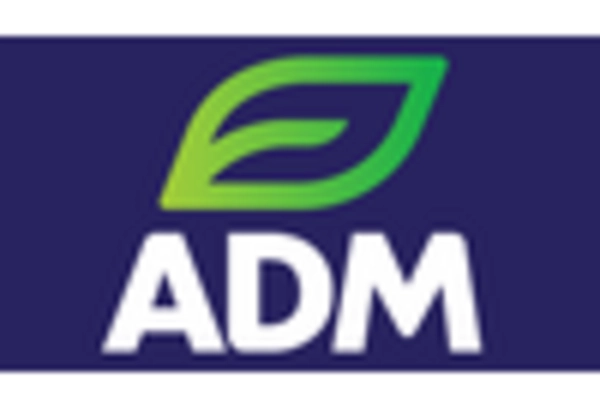Increased Use of Biofuels
The Corn Wet Milling Market is significantly influenced by the growing interest in biofuels, particularly ethanol. Ethanol, produced from corn, serves as a renewable energy source and is increasingly blended with gasoline to reduce carbon emissions. The demand for biofuels is projected to rise, driven by government policies promoting renewable energy and sustainability. In 2025, the ethanol production from corn is expected to reach approximately 15 billion gallons, indicating a robust market for corn-based biofuels. This trend not only supports the Corn Wet Milling Market but also encourages investment in advanced milling technologies to optimize ethanol extraction processes, thereby enhancing overall efficiency.
Health and Wellness Trends
The Corn Wet Milling Market is witnessing a shift towards health and wellness trends, which is influencing consumer preferences for healthier food options. As consumers become more health-conscious, there is an increasing demand for corn-based products that are perceived as natural and nutritious. This trend is reflected in the rising popularity of gluten-free and organic products, which often utilize corn as a primary ingredient. The market for gluten-free products is expected to grow at a CAGR of around 9% in the coming years. Consequently, the Corn Wet Milling Market is adapting to these trends by diversifying its product offerings to include healthier alternatives, thereby capturing a larger share of the market.
Rising Demand for Starch Products
The Corn Wet Milling Market is experiencing a notable increase in demand for starch products, which are derived from corn. Starch is utilized in various applications, including food, pharmaceuticals, and industrial processes. The market for starch is projected to grow at a compound annual growth rate (CAGR) of approximately 4.5% over the next few years. This growth is driven by the expanding food and beverage sector, where starch serves as a thickening agent and stabilizer. Additionally, the pharmaceutical industry increasingly relies on corn-derived starch for drug formulation. As a result, the rising demand for starch products is likely to bolster the Corn Wet Milling Market, encouraging manufacturers to enhance production capabilities and innovate in product development.
Expanding Applications of Corn Derivatives
The Corn Wet Milling Market is experiencing growth due to the expanding applications of corn derivatives across various sectors. Corn derivatives, such as corn syrup, corn oil, and corn gluten meal, are utilized in food production, animal feed, and industrial applications. The food and beverage sector is particularly significant, with corn syrup being a widely used sweetener. The market for corn syrup is projected to grow at a CAGR of approximately 3.5% in the coming years. This diversification of applications is likely to drive demand for corn and its derivatives, thereby positively impacting the Corn Wet Milling Market and encouraging manufacturers to explore new markets and product lines.
Technological Innovations in Milling Processes
The Corn Wet Milling Market is benefiting from technological innovations that enhance milling processes and improve product quality. Advances in milling technology, such as enzyme applications and membrane filtration, are enabling manufacturers to extract higher yields of valuable components from corn. These innovations not only increase efficiency but also reduce waste, aligning with sustainability goals. The implementation of such technologies is expected to lead to a 10% reduction in production costs over the next few years. As a result, the Corn Wet Milling Market is likely to see increased competitiveness and profitability, encouraging further investment in research and development.


















Leave a Comment